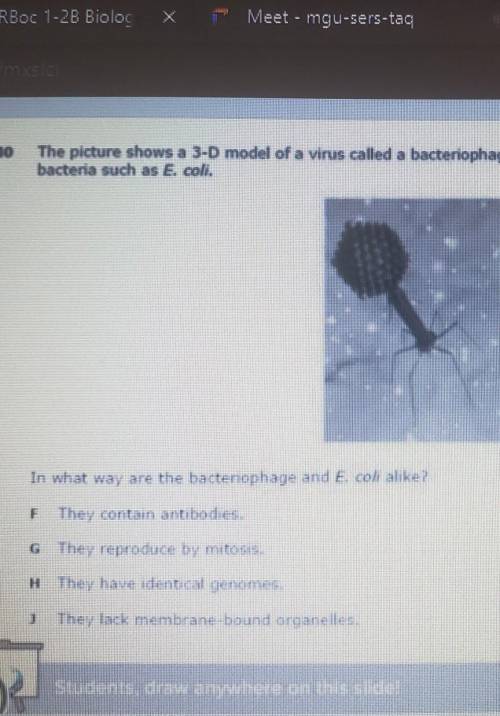
Biology, 03.12.2020 20:10 lanettejohnson355
The picture shows a 3-D model of a virus called a bacteriophage. Bacteriophages can infect In what way are the bactenophage and E. coli alike? F. They contain antibodies. che produce by tutosis. H They have idenbekl genomes, The lack membrane-bound organelles. Students, dawanywhere on this slide!


Answers: 1


Other questions on the subject: Biology

Biology, 21.06.2019 20:00, skylex
You have been asked to lead a demonstration for the undergraduate microbiology lab course about the uses of negative staining when studying bacteria. a "negative" stain does not stain the bacterial cell itself but stains the space between cells. under magnification, the acidic (negativelycharged) nature of the stain will be repelled by the negatively charged bacterial cell wall and willleave the cell colorless in a stained background. negative stains are used primarily to reveal the presence of negatively charged bacterial capsules; therefore, they are also called capsule stains. encapsulated cells appear to have a halo surrounding them. the negative stain procedure does not require heat fixation, which limits any chances of alteration in bacterial cell shape and size. the bacterial suspension is added to a drop of stain, such as nigrosin or eosin, and drawn across the glass slide using a coverslip. nigrosin staining-not safranin staining-of klebsiella pneumoniae will allow for the visualization of the cell shape and the determination of the presence of a capsule. true/false
Answers: 1

Biology, 21.06.2019 22:00, kmh05
Fan egg cell containing the (n+1) number of chromosomes combines with a sperm cell containing the (n) number of chromosomes, what is the result of this union? a) all future somatic cells of the organism will contain the (2n + 1) number of chromosomes. b) all future somatic cells of the organism will contain the (2n - 1) number of chromosomes. c) only certain somatic cells of the organism will contain the (2n + 1) number of chromosomes. d) all future somatic cells of the organism will contain the normal diploid number of chromosomes.
Answers: 2
You know the right answer?
The picture shows a 3-D model of a virus called a bacteriophage. Bacteriophages can infect In what w...
Questions in other subjects:





English, 01.09.2021 02:50

Mathematics, 01.09.2021 02:50

Arts, 01.09.2021 02:50





